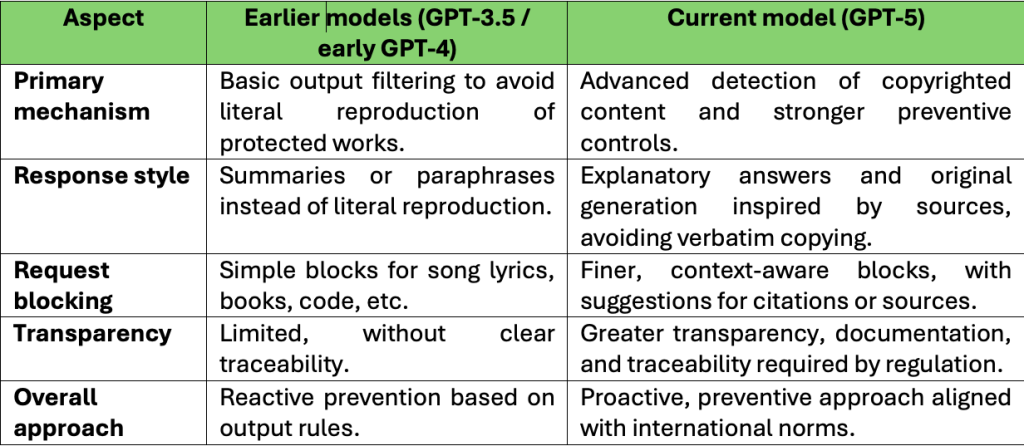By: Eng. María José Rodríguez
On August 2, 2025, the European Union’s new regulatory framework for general-purpose AI (GPAI)[1] models entered into force. The focus? Clear rules on using copyrighted works in AI training and operation.
Among the relevant guidelines is the General-Purpose AI (GPAI) Code of Practice, a voluntary instrument that helps with due compliance with the obligations contained in the AI Act by adding more transparency, safety, and accountability. In practical terms, it helps all market participants understand their obligations and “benchmark” where they stand.
Within this new framework, European rules seek to protect copyright and reinforce the principles of digital law amid the rapid expansion of artificial intelligence. In practice, AI models operating in the European Union—such as ChatGPT or Gemini—must make transparent the protected content they use. They are also required to implement mechanisms that reduce bias, discrimination, and the misuse of others’ works. In other words, the aim is to ensure that innovation advances hand in hand with ethics and the protection of content creators.
New obligations for developers
Companies that develop AI models must:
- Respect copyright: if a creator has reserved the right not to be used for text and data mining, the model must exclude their work.
- Publish a summary of the material used in training to provide visibility into data sources.
- Ensure transparency and safety: share information with integrators about the model’s capabilities, limits, and risks.
Benefits for users and creators
- For users: greater confidence and certainty about the origin of data.
- For creators: protection against the unauthorized use of their works.
- For the market: a fairer framework that combines innovation with respect for intellectual property.
What changes in practice: Until now, AI models could be trained with huge volumes of data without revealing their provenance. Under this new regulation, developers must be transparent and honor rights reservations—moving from a “good-faith” approach to legally verifiable compliance.
Impact for Peru
Although this is a European regulation, its influence is global[2]:
- Peruvian companies exporting solutions to the EU must meet these requirements, including appointing a legal representative on EU territory.
- Peruvian creators benefit indirectly, since the European framework opens a path to demand respect for their works in international AI use.
- The regulation serves as a reference for future policies and rules in Peru, fueling debate on how to balance technological innovation and intellectual-property protection.
The European Union is consolidating itself as a global reference in AI regulation. For Peru’s digital ecosystem, this framework represents both a challenge—in terms of regulatory compliance—and an opportunity to differentiate through responsible innovation aligned with international standards.
And to show how models are adapting to the new regulatory requirements, consider this example: a prompt was put to ChatGPT-5 asking how she differs from earlier versions with respect to copyright protection, and this was the response:
COMPARATIVE TABLE: ChatGPT-5 vs. “ChatGPT-Old”[3]
IN SUM
Companies evolving in a digital-transformation environment should make the most of the mechanisms that technology offers to create more value and position themselves as leaders in their market segment (large, medium, or small). And if they start from “digital zero,” so much the better, because they can avoid later changes (and costs) and reduce contingencies and/or fines.
If your organization would like to learn more about implementing these practices and anticipating future regulatory changes, contact us to arrange specialized advisory services or training.
Eng. María José Rodríguez
Head of Digital Transformation—Kaiteki Regulación[4]
administracion@kaitekiregulacion.pe
[1] “GPAI” refers to AI models trained with general-purpose data and capable of a wide variety of tasks—such as ChatGPT, Gemini, Claude, LLaMA, among others.
Recommended lectures:
https://digital-strategy.ec.europa.eu/en/policies/contents-code-gpai
https://digital-strategy.ec.europa.eu/en/factpages/general-purpose-ai-obligations-under-ai-act
[2] Unfortunately, Peru does not yet have an implementing regulation for a comprehensive AI framework. As such, many organizations sensibly look to the EU rules being developed as a reference.
[3] Table made 100% by AI.
[4] For more on Generative AI, we recommend this explainer
https://www.mckinsey.com/featured-insights/mckinsey-explainers/what-is-generative-ai





